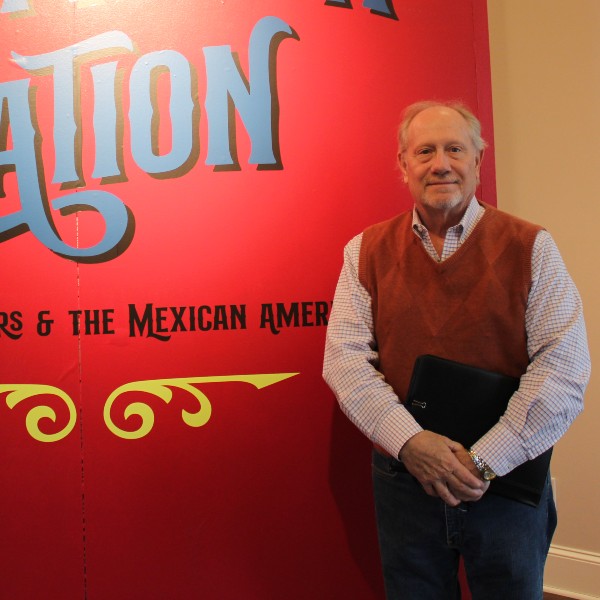Polk museum exhibit curated by esteemed history professor wins state award
Tim Johnson, nationally recognized expert on the Mexican-American War, worked with alumna Kate Gunn to create the 2023 exhibit in Columbia, Tennessee.
Janel Shoun-Smith | 615.966.7078 |

A 2023 museum exhibit at the James K. Polk Home and Museum in Columbia, Tennessee, visited by more than 5,000 people and curated by Lipscomb history faculty Tim Johnson, was awarded a 2023 Tennessee Association of Museums Award of Excellence.
The exhibit, “Shaping A Nation: Tennessee Volunteers & the Mexican-American War”, ran from August 2022 until October 2023 and was developed by both Johnson, Lipscomb’s Elizabeth Gentry Brown Chair in History and a nationally known expert on the Mexican-American War, and alumna Kate Holt Gunn (BA ’20), who now works as the curator of collections at the Polk home.
Gunn, a Columbia native who interned at the Polk home as a teen and participated in the museum’s Polk Academy as a child, said that knowing her former professor and premier war historian was just down the road in Nashville, definitely played a role in choosing to highlight the Mexican-American War as the museum’s first exhibit since the Covid-19 pandemic.
“When visitors come to tour the home, there are usually a lot of questions about the Mexican-American War,” said Gunn. “Because that war was in between the American Revolution and the Civil War, it often gets lost in history.”

Johnson was more than happy to raise awareness of that time in history, 1846 to 1848, which he agrees doesn’t get a lot of attention in the history books or from the general public. He is not aware of any other exhibit like it displayed in Tennessee, he said.
James Knox Polk, of Tennessee, was the eleventh president of the United States, serving from 1845 to 1849. Polk is known for extending the territory of the United States through the Mexican-American War, annexing the Republic of Texas, the Oregon Territory, and the Mexican Cession after winning the war.
Funded by the Tennessee Wars Commission and the Tennessee Historical Commission, the exhibit highlighted Tennesseans who fought in the war, such as William Trousdale and William Campbell, both future governors of the state, and several future Confederate generals like Benjamin F. Cheatham. Together, Gunn and Johnson started collecting artifacts from scratch by reaching out to the Tennessee State Museum and the Tennessee State Library. They also worked their own networks, finding private collectors who were willing to loan artifacts.
The 20-30 artifacts in the exhibit included documents, weaponry, letters, daguerreotypes and a war medal. It generally takes the Polk museum six to nine months to create a complete exhibit for the museum, said Gunn.
Much of Johnson’s work was writing descriptions of each artifact and creating a 30-page narrative on the people involved in the war and the major battles, so that Polk home staff would be able to answer questions about the exhibit. He also gave lectures on the war for the general public during the exhibit’s run.
Gunn said it was both fun and challenging to work with Johnson to take his doctoral-level expertise and re-shape it for an exhibit for the general population, which meant presenting the information in a grade-level writing style for school children and non-historians who visit the site.
In fact the pair developed identification cards about specific Tennesseans in the war, such as William Haskell and Balie Peyton, to hand out to school children who visited, allowing them to learn and identify with their assigned Tennessean as they went through the exhibit. This same approach is used by some of the nation’s top museums to entice school children to learn.
Most people think that teaching is all that one can do with a degree in history, but that is not the case, said Johnson. “Kate Gunn was an excellent student in our department, and now she is using her knowledge and expertise to preserve the past and educate the general public about a past governor and president,” he said.
“The faculty in the history department at Lipscomb encourages all their students to use the skills they taught us, but to also find what we are passionate about,” said Gunn. “The education I received at Lipscomb shaped who I am as a historian, and helped me land my dream job of being a curator.”